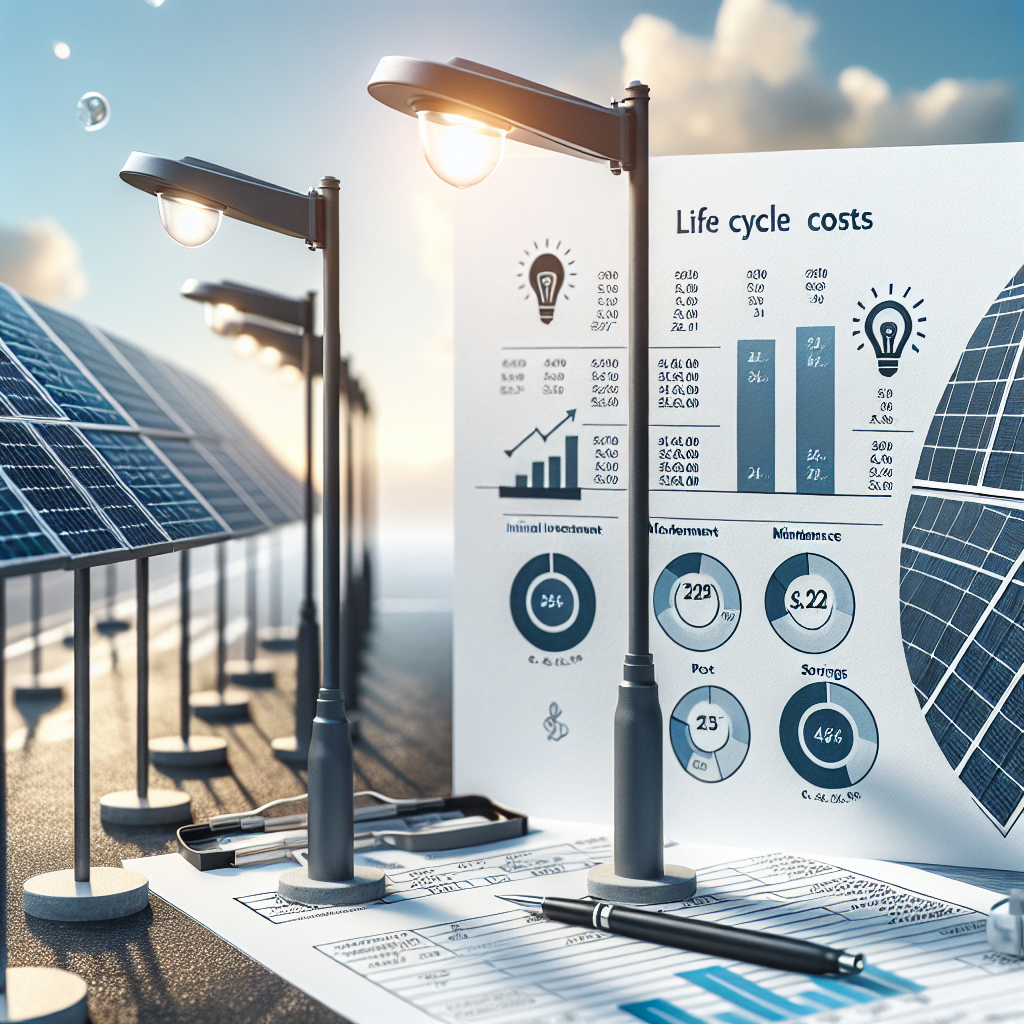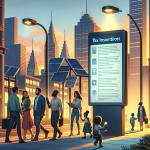Analysing the Life Cycle Costs of Commercial Solar Street Lights
Table of Contents
Analyzing the life cycle costs of commercial solar street lights involves a comprehensive evaluation of the total expenses associated with these systems from installation to decommissioning. This analysis is crucial for stakeholders to understand the long-term financial implications and benefits of investing in solar-powered street lighting. The life cycle cost assessment encompasses initial capital costs, including the purchase of solar panels, batteries, and light fixtures, as well as installation expenses. It also considers operational and maintenance costs over the system’s lifespan, such as battery replacements, cleaning, and repairs. Additionally, the analysis evaluates potential savings from reduced electricity consumption and lower carbon emissions compared to traditional lighting solutions. By examining these factors, decision-makers can make informed choices about the economic viability and sustainability of solar street lighting projects, ultimately contributing to more efficient resource allocation and enhanced environmental stewardship.
Understanding Initial Investment and Installation Costs in Commercial Solar Street Lights
When considering the implementation of commercial solar street lights, understanding the initial investment and installation costs is crucial for stakeholders aiming to make informed decisions. The initial investment in solar street lighting systems encompasses several components, each contributing to the overall expenditure. These components include the cost of solar panels, batteries, LED lamps, poles, and controllers. Additionally, the expenses related to design, engineering, and labor for installation must be factored into the total cost. By examining these elements, stakeholders can better appreciate the financial commitment required at the outset.
Solar panels, as the primary energy source, represent a significant portion of the initial investment. The cost of these panels is influenced by their efficiency, capacity, and the quality of materials used in their construction. High-efficiency panels, while more expensive, can offer better energy output, potentially reducing the number of panels needed and thus impacting the overall cost. Furthermore, advancements in solar technology have led to a gradual decrease in panel prices, making them more accessible to a broader range of projects.
Batteries, essential for storing energy generated during the day for use at night, also contribute substantially to the initial costs. The choice of battery technology, such as lithium-ion or lead-acid, affects both the price and the performance of the solar street lighting system. Lithium-ion batteries, although more costly upfront, offer longer lifespans and better efficiency compared to their lead-acid counterparts. This consideration is vital for stakeholders aiming to optimize long-term performance and cost-effectiveness.
LED lamps, known for their energy efficiency and longevity, are another critical component. The initial cost of LED lamps can be higher than traditional lighting options; however, their reduced energy consumption and extended lifespan can lead to significant savings over time. The choice of LED technology should align with the specific lighting requirements of the project, ensuring adequate illumination while minimizing energy use.
The poles and mounting structures, while often overlooked, are essential for the stability and durability of the solar street lighting system. The material and design of these structures can influence both the initial cost and the ease of installation. Durable materials, such as galvanized steel or aluminum, may incur higher upfront costs but offer better resistance to environmental factors, potentially reducing maintenance expenses in the long run.
Controllers, responsible for managing the flow of electricity between the solar panels, batteries, and lamps, also play a role in the initial investment. Advanced controllers with features such as dimming capabilities and remote monitoring can enhance the efficiency and functionality of the system, albeit at a higher initial cost.
Beyond the cost of individual components, installation expenses must be considered. These include site preparation, labor, and any necessary infrastructure modifications. The complexity of the installation process can vary depending on the location and scale of the project, influencing the overall cost. Efficient project management and skilled labor can help mitigate these expenses, ensuring a smooth installation process.
In conclusion, understanding the initial investment and installation costs of commercial solar street lights involves a comprehensive analysis of various components and their associated expenses. By carefully evaluating these factors, stakeholders can make informed decisions that balance upfront costs with long-term benefits, ultimately contributing to the successful implementation of sustainable lighting solutions.
Evaluating Maintenance and Operational Expenses for Solar Street Lighting Systems

When evaluating the life cycle costs of commercial solar street lights, it is essential to consider not only the initial investment but also the ongoing maintenance and operational expenses. These factors play a crucial role in determining the overall cost-effectiveness and sustainability of solar street lighting systems. As municipalities and businesses increasingly turn to renewable energy solutions, understanding these expenses becomes paramount in making informed decisions.
To begin with, maintenance costs for solar street lights are generally lower than those for traditional lighting systems. This is primarily due to the absence of electrical wiring and the reduced need for frequent bulb replacements. Solar street lights typically use LED technology, which has a longer lifespan compared to conventional bulbs. Consequently, the frequency of maintenance interventions is significantly reduced, leading to lower labor and material costs over time. However, it is important to note that while the maintenance requirements are less frequent, they are not entirely absent. Regular cleaning of solar panels and periodic checks of battery health are necessary to ensure optimal performance.
In addition to maintenance, operational expenses are another critical component of the life cycle costs. Solar street lights operate independently of the grid, which eliminates electricity costs associated with traditional street lighting. This independence from the grid not only reduces operational expenses but also provides a level of resilience against power outages. However, the reliance on solar energy introduces variability in performance due to weather conditions. In regions with limited sunlight, the efficiency of solar street lights may be compromised, potentially necessitating supplementary energy sources or storage solutions, which could increase operational costs.
Furthermore, the choice of battery technology can significantly impact both maintenance and operational expenses. Batteries are a vital component of solar street lighting systems, storing energy for use during nighttime or cloudy days. The type of battery used—whether lead-acid, lithium-ion, or another technology—affects the frequency of replacements and the overall efficiency of the system. Lithium-ion batteries, for instance, offer longer lifespans and higher efficiency but come at a higher initial cost. Therefore, decision-makers must weigh the trade-offs between upfront costs and long-term savings when selecting battery technology.
Another factor influencing maintenance and operational expenses is the geographical location of the solar street lights. In areas prone to extreme weather conditions, such as heavy snowfall or high winds, additional protective measures may be required to safeguard the system. These measures could include reinforced mounting structures or specialized coatings for solar panels, which would add to the initial and ongoing costs. Conversely, in regions with abundant sunlight and mild weather, the operational efficiency of solar street lights is maximized, potentially reducing the need for additional investments.
In conclusion, while the initial investment in commercial solar street lights may be higher than traditional systems, the potential savings in maintenance and operational expenses can make them a cost-effective solution in the long run. By carefully evaluating factors such as maintenance frequency, battery technology, and geographical considerations, stakeholders can optimize the life cycle costs of solar street lighting systems. As the world continues to shift towards sustainable energy solutions, understanding these dynamics is crucial for making informed decisions that balance economic and environmental benefits.
Assessing Long-term Savings and Environmental Impact of Solar-powered Street Lights
In recent years, the adoption of solar-powered street lights has gained significant traction as municipalities and businesses seek sustainable and cost-effective solutions for public lighting. The life cycle costs of commercial solar street lights, encompassing initial investment, maintenance, and operational expenses, are crucial in assessing their long-term savings and environmental impact. By examining these factors, stakeholders can make informed decisions that align with both economic and environmental objectives.
Initially, the upfront costs of solar street lights may appear higher compared to traditional lighting systems. This is primarily due to the integration of photovoltaic panels, energy storage systems, and advanced control technologies. However, it is essential to consider the broader financial picture. Traditional street lights incur ongoing electricity costs, which can be substantial over time. In contrast, solar street lights harness renewable energy from the sun, eliminating electricity expenses and providing a hedge against fluctuating energy prices. Consequently, the initial investment in solar technology can be offset by significant savings in operational costs over the lifespan of the system.
Moreover, maintenance costs for solar street lights tend to be lower than those for conventional lighting systems. Traditional street lights often require frequent bulb replacements and repairs due to their reliance on electrical grids and susceptibility to power surges. Solar street lights, on the other hand, are designed with durable components that require minimal maintenance. The use of LED technology, known for its longevity and energy efficiency, further reduces the need for frequent replacements. Additionally, the decentralized nature of solar street lights means that issues can be addressed on an individual basis, rather than necessitating widespread repairs across an entire grid.
Beyond financial considerations, the environmental impact of solar-powered street lights is a compelling factor in their favor. Traditional street lighting systems contribute to greenhouse gas emissions due to their dependence on fossil fuel-based electricity. In contrast, solar street lights operate on clean, renewable energy, significantly reducing carbon footprints. This shift not only aligns with global efforts to combat climate change but also enhances the sustainability profile of communities and businesses that adopt these systems. Furthermore, the reduction in light pollution, achieved through advanced control systems that adjust lighting levels based on real-time needs, contributes to preserving natural ecosystems and improving the quality of life for residents.
In addition to these benefits, the integration of smart technologies in solar street lights offers further advantages. Features such as remote monitoring and adaptive lighting controls enable efficient energy management and enhance public safety. By adjusting lighting levels based on pedestrian and vehicular traffic, these systems optimize energy use while ensuring adequate illumination. This adaptability not only extends the lifespan of the lighting components but also maximizes the return on investment.
In conclusion, while the initial costs of commercial solar street lights may be higher than traditional systems, their long-term savings and environmental benefits make them a viable and attractive option. By eliminating electricity costs, reducing maintenance expenses, and minimizing environmental impact, solar street lights offer a sustainable solution that aligns with both economic and ecological goals. As technology continues to advance, the potential for even greater efficiencies and innovations in solar street lighting systems promises to further enhance their appeal and effectiveness in the years to come.
Read more about Solar Street Lighting:








